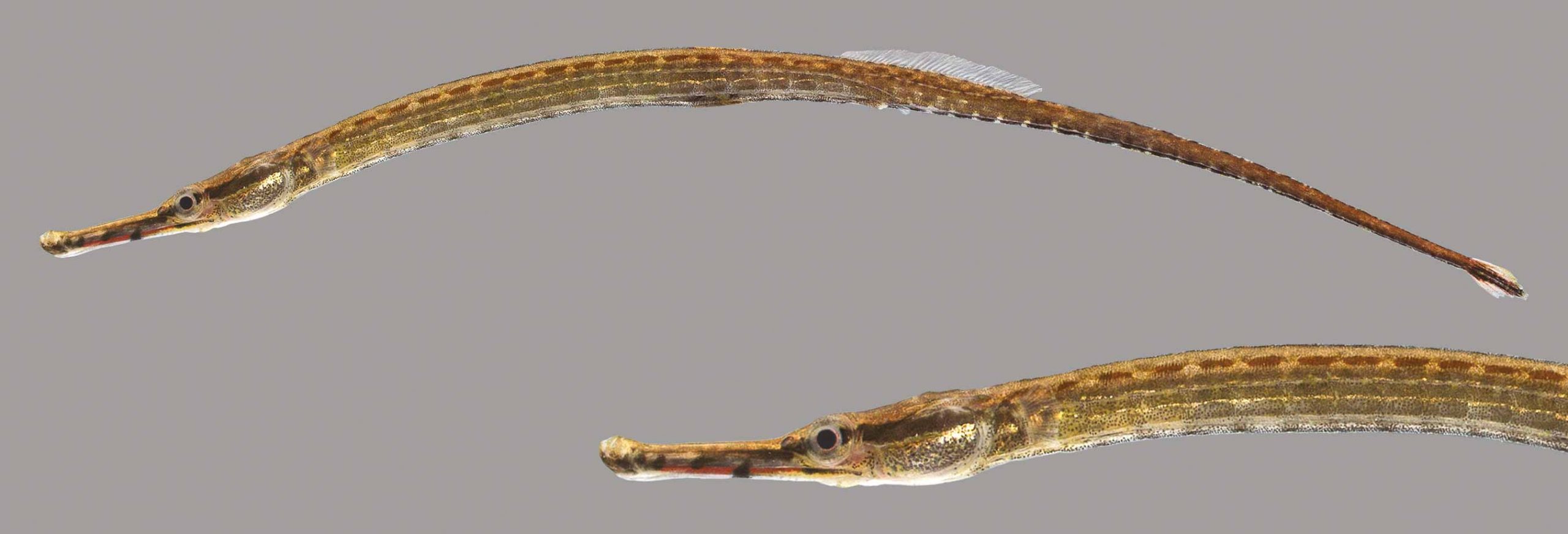I recently posted an article about the seahorses of the Florida panhandle. It would be remiss of me if I did not include their close cousins the pipefish. Where seahorses are well known but hard to find, pipefish are easy to find but not well known.
Pipefish are in the same family as seahorses, Syngnathidae, and are basically elongated seahorses. Pulling seine nets in local grassbeds we often catch them. Students always ask what they are. “Are these needlefish?” is a frequent question. I reply “no, they are pipefish”. Which then comes “pikefish?”. To which I reply “No, PIPEfish… like P-I-P-E… – they are basically elongated seahorses”. And then there is always – “coool”. To which I reply “yes… very cool”.
Pipefish have the same body armor, body rings, and long tube snout of the seahorse. However, they lack the curled prehensile tail for a more elongated body, looking more a grass blade than their cousins. They actually have a caudal fin (the fin most call “fish tail”). Most range between 3-6 inches long but the chain pipefish can reach a length of 10 inches, this is the “big boy” of the group. Like seahorses, they hide in the grass using their tube-shaped mouths to suck in small planktonic food. Like the seahorses, the males’ possess a brood pouch to carry the fertilized eggs and give live birth (ovoviviparous).
The pipefish can quickly be divided into two groups – those with long snouts, and those with short – and this can be easily seen when captured in a net. After that identification gets a bit tricky, you have to count rays in the fins or rings on the body. It is sufficed to say, “it’s a pipefish” and leave it at that.
Those with long snouts include the Opossum, Chain, Dusky, and Sargassum pipefish.
The Opossum Pipefish (Microphis brachyurus) is about 3 inches long and was not reported from the northwestern Gulf of Mexico according to Hoese and Moore1. In the eastern Gulf, our way, it is considered rare but has been found in salt marshes, seagrasses, and in Sargassum mats drifting in from the Gulf. The Florida Museum of Natural History list this fish as a “marine invader”2. In 1991 NOAA listed it as a species of concern due to its decline across the region3. There are reports of this pipefish entering freshwater creeks within our estuaries.
The Chain Pipefish (Syngnathus louisianae) has a very long snout and is the “big boy” of the group reaching 10 inches in length. It is quite common along the panhandle and has one of the larger ranges of this group, found all along the Atlantic coast, throughout the Gulf of Mexico and in the Caribbean.
The Dusky Pipefish (Syngnathus floridae) is a long-snout, large pipefish reaching a length of eight inches. It prefers higher salinity than many pipefish and is found throughout the Gulf of Mexico and along the Atlantic seaboard often offshore.
The Sargassum Pipefish (Syngnathus pelagicus). This is a good scientific name for this fish (pelagicus) for it lives on the large mats of Sargassum weed that drifts across the oceans. Because of this it has a worldwide distribution. This longnose pipefish reaches the typical length of six inches. It lives as many other pipefish do hiding in the grass snapping up food when it comes close enough but it’s habitat is often drifting offshore and inshore sightings of this species are rare.
There are three species of “short-snout” pipefish.
The Fringed Pipefish (Anarchopterus crinigerus) is a smaller pipefish reaching only three inches. It seems to be absent in the western Gulf but is found along the Florida panhandle, the Gulf coast of peninsula Florida, and through the Caribbean to Brazil.
The Northern Pipefish (Syngnathus fuscus) reaches a length of six inches. It is very common along the Atlantic seaboard but Hoese and Moore1 report only four specimens from the Gulf of Mexico. This one would be considered very rare, and an expert should identify it if one thinks they have it.
The Gulf Pipefish (Syngnathus scovelli) is one of the more common pipefish collected in our waters. It is a short-snout species reaching the typical six inches but has these distinct bluish-gray bars that run vertically along the sides. It is found throughout the Gulf of Mexico and even into some freshwater habitats. The Florida Museum of Natural History also list this species as a marine invader4.
I am not sure how much seining you do along our waterways, but if you do any within the grassbeds you are sure to find one of these unique and interesting fish.
References
1 Hoese, H.D., Moore, R.H. 1977. Fishes of the Gulf of Mexico. Texas A&M Press, College Station TX. Pp. 327.
2 Opossum pipefish. Discover Fishes. Florida Museum of Natural History. https://www.floridamuseum.ufl.edu/discover-fish/florida-fishes-gallery/opossum-pipefish/.
3 Opossum Pipefish. Species of Concern. National Oceanic and Atmospheric Administration, National Marine Fisheries Service. https://www.nrc.gov/docs/ML1224/ML12240A312.pdf.
4 Gulf Pipefish. Discover Fishes. Florida Museum of Natural History. https://www.floridamuseum.ufl.edu/discover-fish/florida-fishes-gallery/gulf-pipefish/.
- Our Environment: Part 10 – Improving Agriculture - June 20, 2025
- Marine Creatures of the Northern Gulf – Snails and Slugs - June 20, 2025
- Our Environment: Part 9 – Agriculture Challenges - June 6, 2025

